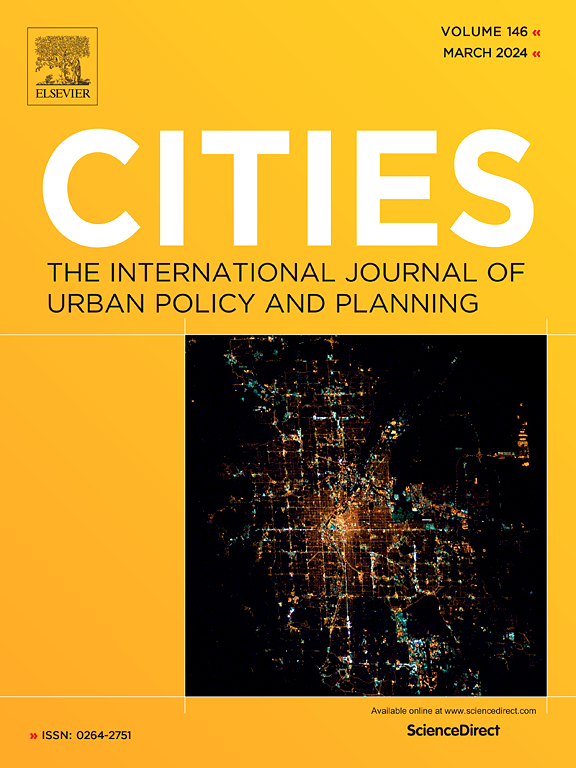Using spatially explicit high-granularity 3D geospatial data for quantifying public transport walking accessibility inequality and vulnerability in the x-minute city
IF 6
1区 经济学
Q1 URBAN STUDIES
引用次数: 0
Abstract
Public transport (PT) plays a crucial role as a fundamental urban amenity, facilitating access to destinations beyond walking distance. The concept of the x-minute city underscores the importance of having essential urban amenities like PT within a short active travel time, i.e., good PT walking accessibility. However, significant gaps persist in understanding two key aspects within the framework of the x-minute city: (1) PT walking accessibility that integrates high-granularity three-dimensional (3D) walkability constraints (including indoor footpaths) and accounts for inter-modal ridership weight differences, referred to as enhanced 3D PT walking accessibility (E3D-PTWA); and (2) vulnerability distribution arising from low E3D-PTWA and low income—a socioeconomic condition often accompanied by heightened PT dependency—thereby compounding vulnerability. This study addresses these gaps by focusing on Hong Kong as a case study of a transit-dependent and topographically complex city. Using the two-step floating catchment area (2SFCA) method and median-based measure, we compute E3D-PTWA at Hong Kong's fine-grained census unit, i.e., Large Subunit Groups (LSUGs), and its associated inequality and vulnerability across different districts. The results from this research reveal that districts in the New Territories and Kowloon exhibit a higher proportion of vulnerable LSUGs with both limited E3D-PTWA and low income, while districts on Hong Kong Island tend to have a lower percentage of such vulnerable groups. These findings emphasize the need to address the unequal distribution of PT services among the population and improve E3D-PTWA to promote sustainable and livable urban environments.
利用空间显式高粒度三维地理空间数据量化x分钟城市公共交通步行可达性不平等和脆弱性
公共交通(PT)作为一种基本的城市设施发挥着至关重要的作用,使人们能够超越步行距离到达目的地。x分钟城市的概念强调了在短时间内拥有像PT这样的基本城市设施的重要性,即良好的PT步行可达性。然而,在了解x分钟城市框架内的两个关键方面仍然存在重大差距:(1)PT步行可达性集成了高粒度三维(3D)步行可达性约束(包括室内人行道)并考虑了多式联运乘客体重差异,称为增强3D PT步行可达性(E3D-PTWA);(2)低E3D-PTWA和低收入导致的脆弱性分布——这一社会经济条件往往伴随着对PT的高度依赖——从而加剧了脆弱性。本研究以香港为个案,以香港作为一个依赖公共交通和地形复杂的城市,以解决这些差距。采用两步浮动集水区(2SFCA)方法和基于中位数的测量方法,计算了香港细粒度人口普查单位(即大亚单位群)的E3D-PTWA及其在不同地区的不平等和脆弱性。本研究结果显示,新界和九龙地区的弱势lsug比例较高,且E3D-PTWA有限,收入较低,而香港岛地区的弱势群体比例较低。这些发现强调需要解决PT服务在人口中分配不均的问题,并改善E3D-PTWA,以促进可持续和宜居的城市环境。
本文章由计算机程序翻译,如有差异,请以英文原文为准。
求助全文
约1分钟内获得全文
求助全文
来源期刊

Cities
URBAN STUDIES-
CiteScore
11.20
自引率
9.00%
发文量
517
期刊介绍:
Cities offers a comprehensive range of articles on all aspects of urban policy. It provides an international and interdisciplinary platform for the exchange of ideas and information between urban planners and policy makers from national and local government, non-government organizations, academia and consultancy. The primary aims of the journal are to analyse and assess past and present urban development and management as a reflection of effective, ineffective and non-existent planning policies; and the promotion of the implementation of appropriate urban policies in both the developed and the developing world.
 求助内容:
求助内容: 应助结果提醒方式:
应助结果提醒方式:


